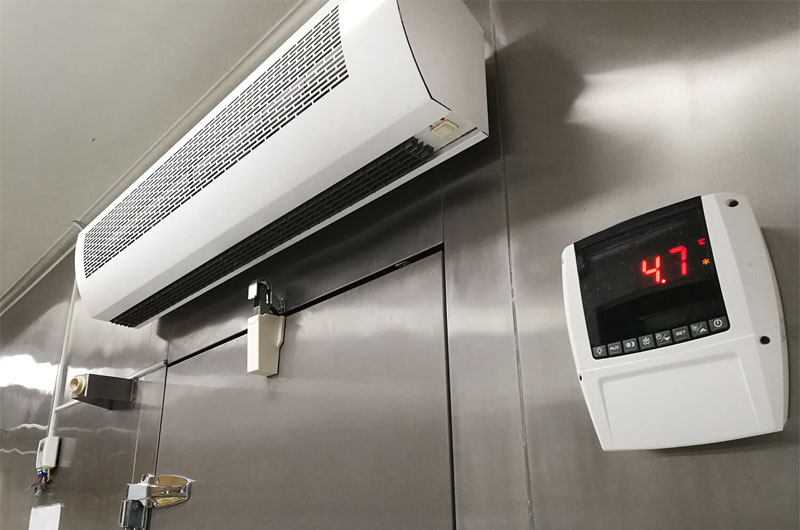Cold rooms are specially designed refrigerated environments that maintain specific temperature ranges to preserve perishable goods, prevent spoilage, and ensure safety and quality.
Understanding the temperature ranges of cold rooms is essential for selecting the right cold storage solution tailored to your needs.
Why Temperature Control Matters
Temperature is the most critical factor affecting the shelf life, safety, and quality of stored products. Higher temperatures speed up microbial growth, enzymatic reactions, and chemical changes, causing spoilage or deterioration. Cold rooms slow down these processes by maintaining a stable, low-temperature environment, thus reducing wastage and ensuring compliance with regulatory standards.
Types of Cold Rooms by Temperature Range
Cold rooms are generally classified into three major categories based on their temperature ranges:
1. Chiller Rooms (Above Freezing)
- Temperature Range: 0°C to +10°C (32°F to 50°F)
- Purpose: Primarily used for storing fresh fruits, vegetables, dairy products, beverages, and some pharmaceuticals that require cool but not freezing conditions.
Key Features:
- Keeps temperatures slightly above freezing to inhibit microbial growth and slow enzyme activity.
- Ideal for products sensitive to freezing damage but that still need to be kept cool.
- Widely utilized in supermarkets, restaurants, and food processing facilities.
Applications:
- Fresh produce storage: Apples, leafy greens, and berries stay fresh longer.
- Dairy products: Milk, cheese, and yogurt need refrigeration but must be kept from freezing.
- Meat and fish before freezing: Keeps products fresh prior to further processing.
2. Freezer Rooms (Below Freezing)
- Temperature Range: -18°C to -25°C (0°F to -13°F)
- Purpose: Built for freezing and storing items like meat, seafood, frozen vegetables, ice cream, and pharmaceuticals that require deep freezing.
Key Features:
- Prevents microbial growth by freezing water content inside products.
- Maintains long-term preservation by halting enzymatic activity.
- Requires thicker insulation and more powerful refrigeration systems than chillers.
Applications:
- Frozen food storage in food processing and distribution centers.
- Meat and poultry storage for retail and wholesale.
- Pharmaceutical storage, especially vaccines and biologics requiring deep freeze.
3. Blast Freezers and Ultra-Low Temperature Rooms
- Temperature Range: -30°C to -40°C (-22°F to -40°F) or even lower
- Purpose: Rapid freezing of products to preserve texture, taste, and nutritional quality.
Key Features:
- Blast freezers quickly reduce the temperature of fresh products, minimizing ice crystal formation that damages cell structure.
- Ultra-low temperature rooms are used to preserve highly sensitive biological samples and pharmaceuticals.
- Advanced insulation and refrigeration technology required.
Applications:
- Food industry: Rapid freezing of seafood, meats, and prepared meals.
- Pharmaceutical and biomedical sectors: Storage of vaccines, tissue samples, and research materials.
- Specialty products requiring ultra-low temperature preservation.
Typical Cold Room Temperature Settings by Industry
| Industry | Typical Temperature Range | Description |
|---|---|---|
| Fresh Produce | +0°C to +4°C (32°F to 39°F) | Prevents ripening and decay of fruits and vegetables. |
| Dairy Products | +2°C to +6°C (36°F to 43°F) | Maintains freshness without freezing. |
| Meat and Poultry | -18°C to -22°C (0°F to -8°F) | Freezing to ensure long shelf life. |
| Seafood | -18°C to -25°C (0°F to -13°F) | Prevents spoilage and bacterial growth. |
| Pharmaceuticals | +2°C to +8°C (36°F to 46°F) | Storage of medicines requiring refrigeration. |
| Vaccines & Biologics | -20°C to -80°C (-4°F to -112°F) | Ultra-low temps for vaccine integrity. |
Factors Affecting Cold Room Temperature Control
1. Insulation Quality
Proper insulation is vital to maintaining the cold room’s temperature. High-quality insulation minimizes heat transfer from outside and reduces energy consumption.
2. Refrigeration System
The cooling capacity and efficiency of the refrigeration system must match the size, insulation, and intended use of the cold room. Different temperature ranges require different refrigeration technologies.
3. Temperature Monitoring and Control
Advanced control systems with digital thermostats, alarms, and remote monitoring ensure consistent temperature maintenance and immediate alerts on deviations.
4. Humidity Control
In some cold rooms, controlling humidity alongside temperature is critical to prevent moisture loss or condensation, which can affect product quality.
Choosing the Right Temperature Range for Your Cold Room
Selecting the appropriate cold room temperature depends on:
- Type of products stored: Fresh produce vs frozen meat requires vastly different conditions.
- Duration of storage: Short-term chill vs long-term frozen storage.
- Regulatory requirements: Food safety standards often mandate specific temperature controls.
- Operational workflow: For example, in a food processing plant, a sequence of chiller, blast freezer, and freezer rooms may be used.
Common Cold Room Temperature Problems and Solutions
Problem: Temperature Fluctuations
- Cause: Poor insulation, faulty doors, or inadequate refrigeration.
- Solution: Regular maintenance, sealing gaps, upgrading insulation.
Problem: Frost Build-up
- Cause: High humidity or frequent door openings.
- Solution: Use of defrost systems and controlling humidity levels.
Problem: Energy Inefficiency
- Cause: Overcooling or inefficient refrigeration units.
- Solution: Use energy-efficient systems and proper temperature settings.

